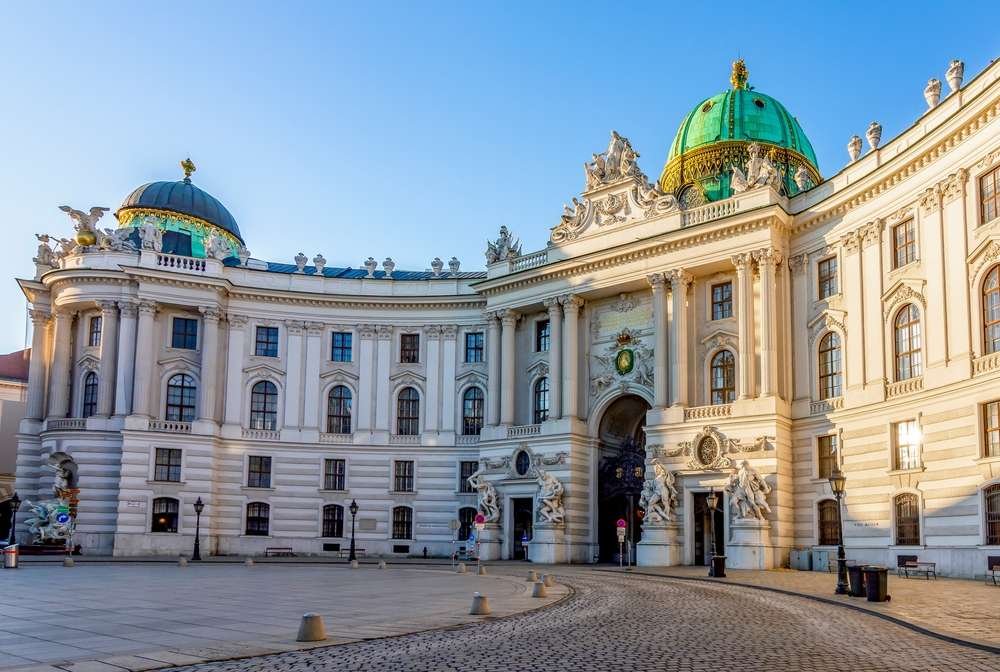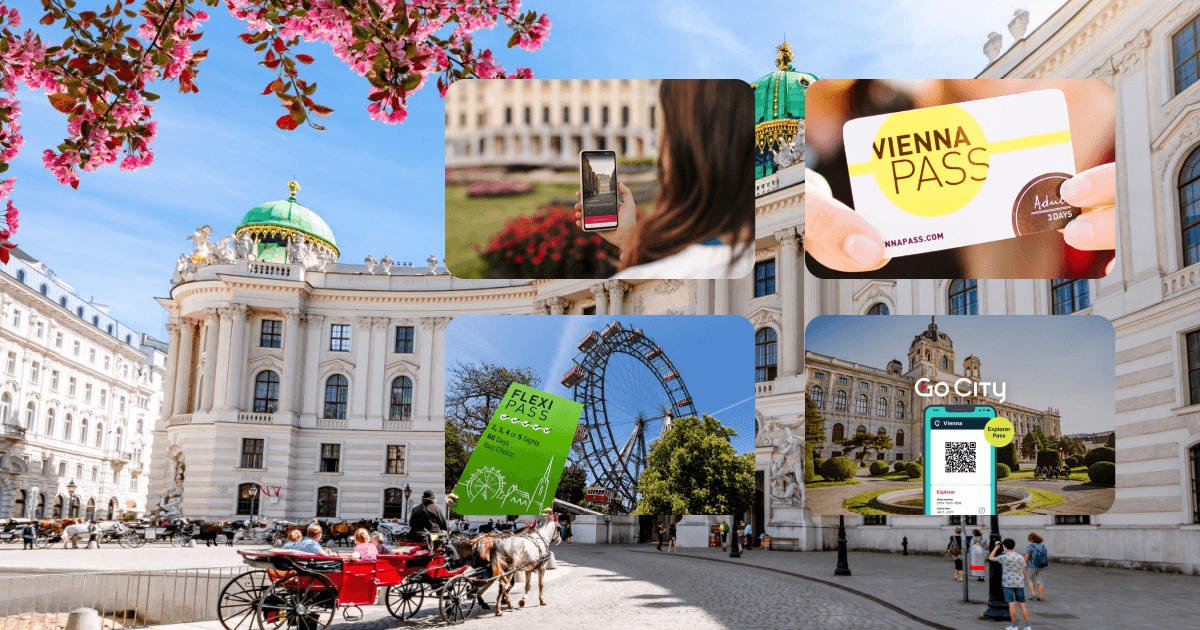The Imperial Apartments, the Sisi Museum and the Silver Collection are located
Guide to Hofburg Imperial Palace: Tickets, Tips, History...
Hofburg Imperial Palace is one of the top 10 things to do in Vienna.
What can I see in the largest castle complex in the world?
What is the Hofburg Imperial Palace?
The 13th-century Hofburg Imperial Palace is an imposing complex of buildings in the center of Vienna. It has been the residence of various rulers of the Holy Roman Empire, the Habsburg Monarchy, the Austro-Hungarian Monarchy over the centuries and has served as the official residence of the Austrian Federal President since 1946.
The Hofburg Palace covers an area of 240,000 square meters and includes numerous buildings, gardens, courtyards and squares. It is an outstanding example of architectural development through the centuries, as the buildings feature different styles, including Gothic, Baroque, and Neoclassical elements.
Highlights in the Hofburg Imperial Palace
The most important sights in the Hofburg Imperial Palace include the Imperial Apartments with the Sisi Museum, the Imperial Treasury with the crown of the Holy Roman Empire, the State Hall of the National Library, the Spanish Riding School and the World Museum.
Admission: The Hofburg Imperial Palace consists of various museums with their own entrance and different opening times. The entrance tickets for the individual museums are listed below.

Popular Ticket Options for the Must-Sees of the Hofburg Imperial Palace
There are numerous websites offering tickets for the attractions at the Hofburg Imperial Palace in Vienna, which can make it challenging to choose the right tickets. That's why we've done the work for you and compared all the available options.
Below, you'll find a curated list of the best and most popular tickets for the Hofburg Palace, including the cheapest options. Simply click on your preferred choice to purchase your tickets. Detailed descriptions of the various attractions can be found further below.
Spanish Riding School
- Overview of all Spanish Riding School Tickets
- Vienna Spanish Riding School Guided Tour
- Performance of The Lipizzans at Spanish Riding School
- Spanish Riding School morning training tickets
- Combo ticket: Spanish Riding School Vienna with music + tickets for the Upper Belvedere Palace
- Tickets for Horse Training at the Spanish Riding School
- Tickets for Guided Tour at the Spanish Riding School
- Tickets for Lipizzaner Performance at the Spanish Riding School
- Spanish Riding School: From Stables to Attic Floors Tour
- Spanish Riding School Tour + Horse Training
- Kunsthistorisches Museum + Horse Training
- Vienna FLEXI Pass: Save 30% on Your Choice of 2-5 Top Attractions including Spanish Riding School
Sisi Museum (Imperial Apartments)
- Hofburg and Empress Sisi Museum Guided Tour (recommended)
- Entrance Ticket for the Sisi Museum
- Skip-the-Line Hofburg Ticket & Sisi Museum Tour
- Tickets for Vienna: Skip-the-Line Sisi Museum, Hofburg Palace and Gardens Tour
- Tickets for Hofburg Palace and Sisi Museum: Guided Tour
- Tickets for Sisi Museum Hofburg Vienna: Small-group Guided Tour with Priority Entrance
- Tickets for Empress Elisabeth: Imperial Treasury Vienna + Imperial Carriage Museum
Imperial Treasury
- Overview of the Best Ticket Options for the Imperial Treasury.
- Ticket to the Imperial Treasury in the Hofburg Palace
- Combo ticket for the Imperial Treasury, the Kunsthistorisches Museum & Kunstkammer Vienna
- Private Tour of the Hofburg Imperial Palace with the Imperial Treasury + Highlights of the Old Town
- Tickets for Empress Elisabeth: Imperial Treasury Vienna + Imperial Carriage Museum
Albertina Museum
- Ticket Overview for the Albertina Museum
- Albertina Admission Ticket
- Albertina + Albertina Modern
- Albertina + Belvedere Palace: Upper Belvedere
- Albertina + Schönbrunn Zoo
- Albertina + St. Stephen's Cathedral: Museum, Treasury, Catacombs, Towers
- Albertina + Leopold Museum Skip-the-Line Ticket
Weltmuseum (World Museum)
Spanish Riding School
Home of the Lipizzaner Horses in Vienna
What is the Spanish Riding School?
The Spanish Riding School is the only institution in the world to preserve the old equestrian tradition of the "High School" by dedicating itself to the classic training and dressage of the famous Lipizzaner horses for over 450 years. Since 2015, horsemanship has been part of the UNESCO Intangible Cultural Heritage of Humanity.
During a visit to the court riding school, you can experience the world-famous art of riding up close and be enchanted by the oldest breeding horse breed in Europe. In the impressive baroque winter riding school, the most beautiful riding hall in the world, a grandiose atmosphere awaits you, coupled with an unforgettable riding spectacle. The performances, also known as the "Ballet of the White Stallions", are very popular. Just as exciting is the "morning work" and guided tours through the court riding school.
How to get to the Hofburg Palace by Public Transport?
For the central area of the Hofburg complex, we have chosen the wing that houses the Spanish Riding School and the Sisi Museum. The walking directions provided are from this specific point.
Public Transport Options:
- By metro (U-Bahn):
Line U3 to Herrengasse and 3 minutes on foot
Lines U1 and U3 to Stephansdom and 6 minutes walk - By tram:
1, 2, 71 and D to Burgring, Ring/Volkstheater or Parlament and 7 minutes on foot - By bus:
1A and 2A to Michaelerplatz or Habsburgergasse and 1 to 2 minutes on foot
Timetables:
Vienna Roadwork Maps:

The most popular and best-selling tickets for Vienna
Planning to stay a bit longer in Vienna and explore more of the Austrian capital? We have compiled a list of the most sought-after tickets according to the popular ticket portals GetYourGuide, Headout and Tiqets. Simply click on the description of the ticket that interests you to secure your favorites.
- Skip-the-Line Ticket for Schönbrunn Palace and Gardens + 2-hour Guided Tour in English, Spanish or Italian
- Tickets for the Training at the Spanish Riding School
- Skip-the-Cashier-Desk-Line Ticket for a Ride on the Vienna Giant Ferris Wheel
- Tickets for Vivaldi's Four Seasons concert in Karlskirche
- Tickets for a Hop-On Hop-Off Sightseeing Tour: 24, 48 or 72 hours
- Skip-the-Line Ticket for Schönbrunn Zoo
- Ticket for the Upper Belvedere, including Klimt's Kiss and the Permanent Collection
- Tickets for Belvedere Palace: Lower Belvedere and other Ticket Options
- Albertina: State Rooms, Permanent Collection Batliner, Temporary Exhibitions
- Entrance Ticket to the Kunsthistorisches Museum in Vienna
- Tickets for the Museum of Illusions
Parks in the Area
How to Spend Your Free Time in the Hofburg Imperial Palace

1. Volksgarten
Volksgarten is in the Hofburg Imperial Palace complex and is part of the Historic Center of Vienna UNESCO World Heritage Site. It was created in 1821 by Ludwig Remy. Noteworthy are the Theseus Temple, a scaled-down replica of the ancient Theseion in Athens, and the rose garden with over 3,000 rose bushes, a popular photo motif for wedding couples. The history of the Volksgarten Club/Disco in the park goes back over 180 years.

2. Burggarten
Burggarten, which was originally laid out as an imperial private garden, is a public park in the style of English landscape gardens. The Palm House, which is one of the largest of its kind in the world, was commissioned by Emperor Franz Joseph in 1882. It houses plants from three climate zones. Free-flying butterflies can be found in the butterfly house. There are also numerous monuments, among them a Mozart monument.

Other Museums and Institutions
What Else Can I See?
In addition to the top attractions already mentioned, there are many other fascinating museums and collections in the Hofburg Imperial Palace.

History of the Hofburg Imperial Palace
When Michaelerplatz on the north side of the Hofburg Imperial Palace was redesigned in the 1990s, the almost 2,000-year-old ruins of the Vindobona Roman military camp, which once stood here, were discovered.
The Hofburg Imperial Palace itself was originally built in the 13th century. The Gothic castle chapel, in which the Vienna Boys' Choir perform masses on Sundays, is still reminiscent of the medieval castle.
Over the centuries, the Hofburg Palace was expanded again and again by the respective emperors. The numerous extensions gave the mighty building complex, consisting of 18 wings, 19 courtyards and 2,600 rooms, its current appearance.
The Habsburg Empire was ruled from here for almost 700 years. Until the end of the monarchy in 1918, the imperial family lived in the Hofburg Palace.
As the seat of the Austrian Federal President, it is still the political center of Austria.
The three most important periods of its development were the following:
The 3 Most Important Periods

Traveler's Tip: City Passes for Vienna
Vienna offers several appealing city passes for travelers that can help you save money and time. We highly recommend purchasing one of these cards.
To learn more about the popular tourist cards, including prices and included activities, check out our article "Best City Pass for Vienna: Compare Prices & Included Activities". Alternatively, you can easily compare and purchase the card of your choice by clicking on one of the buttons below the following brief descriptions.
1. Vienna City Card
The Vienna City Card is available for 24, 48, or 72 hours, providing discounts at 200 attractions, museums, restaurants, theaters, and stores. Additionally, it offers unlimited and free use of public transportation.
2. Vienna Pass
The Vienna Pass is available for 1, 2, 3, or 6 days and grants you free admission to over 60 attractions in Vienna. It often allows you to skip the queues.
3. Vienna Flexi Pass
The Vienna Flexi Pass allows you to choose your favorite 2 to 5 attractions from a selection of over 40 options. You can visit them for free and, if available, enjoy fast-track admission.
4. Go City Explorer Pass
The Go City Explorer Pass enables you to choose your favorite 2 to 7 attractions from over 40 options in Vienna. You can visit them for free and, if available, enjoy fast-track admission.
More Interesting Places in the Hofburg Imperial Palace
Insider Tips for Non-Viennese

Lorettokapelle
Heart crypt of the Habsburgs in the Augustinian church

Roman ruins
On Michaelerplatz in front of the entrance to the Hofburg Imperial Palace in the city center
Address & Map
Address: Hofburg, Heldenplatz, 1010 Vienna
